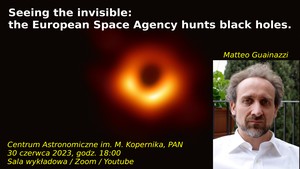

Wykłady odbywają się w okresie od października do czerwca, raz w miesącu, w poniedziałki o godzinie 18:00.
NASA's Juno mission has been providing a rush of new insights into Jupiter, our solar system's largest planet. Since arriving at Jupiter in 2016, Juno has explored the depths of Jupiter's complex, stormy atmosphere, and has given us new views on Jupiter's interior structure, its complex magnetic field, and its past evolution. This talk will focus on several of the main science highlights from the mission.
Wykład w języku angielskim. Możliwe będzie zadawanie pytań i wygłaszanie komentarzy po polsku (te będą tłumaczone na żywo).
Dr. Matteo Guainazzi (European Space and Technology Center of ESA, Noordwijk, The Netherlands)
Black holes lurk everywhere in the cosmos. They shape the evolution of the galaxies hosting them, constitute unique laboratory of extreme physics, and could contribute to the elusive "dark matter". Being "dark", Humankind has been able only very recently to take direct "images" of their shadow. However, their surroundings are far from being "dark": they are copious sources of high-energy radiation, X-rays and γ-rays. Space observatories of the European Space Agency (ESA) have been chasing these signals for decades, and the Polish scientific community has given a key contribution to their understanding. Furthermore, pairs of black holes dancing around each other trigger ripples in the space-time fabric: gravitational waves, which Humankind has also recently learned to decode. ESA is preparing the first space-born mission to listen to the gravitational cry of black holes in the last phases of their dramatic merging. How can we "see" the "invisible" black holes? What have they taught us on the history of the Universe? How does matter behave under the extreme physical conditions in their surroundings? These will be amongst the questions that I will address in my talk.
Wykład w języku angielskim!
Na Zoom będzie opcja napisów tłumaczonych automatycznie na język polski. Szczegóły w instrukcji dla użytkowników Zoom.
Uczestnicy w sali wykładowej otrzymają gratis książkę "Across the Universe. Research at the Nicolaus Copernicus Astronomical Center of the Polish Academy of Sciences".
Transmisja w ![]()
Matteo Guainazzi is staff astronomer at the European Space and Technology Center of ESA (Noordwijk, The Netherlands). He has been working for almost a quarter of a century on the design, development and science operations of X-ray observatories of ESA (XMM-Newton, Athena), ASI (BeppoSAX), and JAXA (ASCA, Hitomi, XRISM). His research focuses on understanding the feeding of and feedback by supermassive black holes, as well as the physical processes occurring in the immediate surrounding of the black hole event horizon, employing X-ray observations of "active galaxies". He is Sicilian, 56 years old, has been living abroad (Netherlands, Spain, Japan ) over almost his entire adult life.
